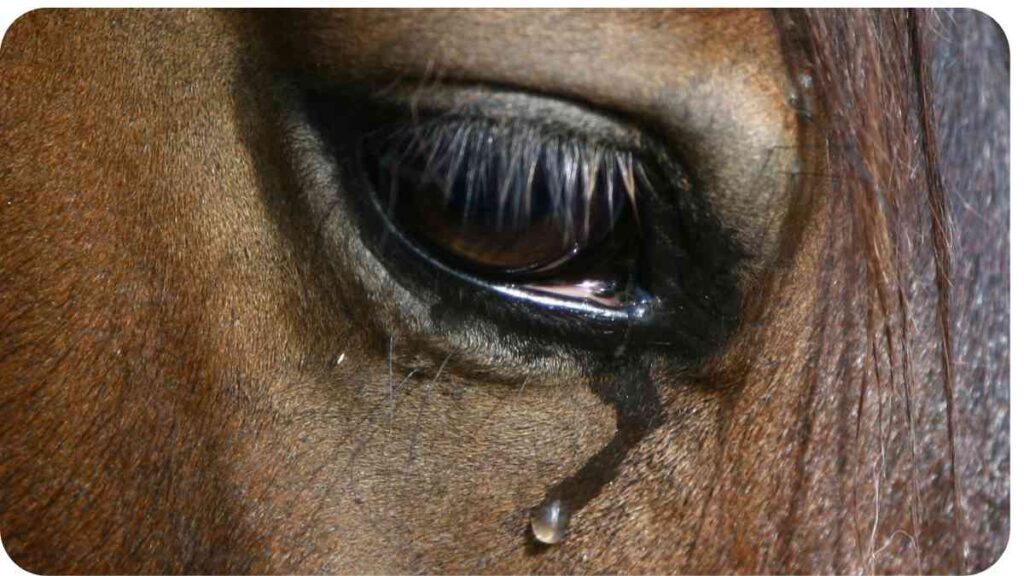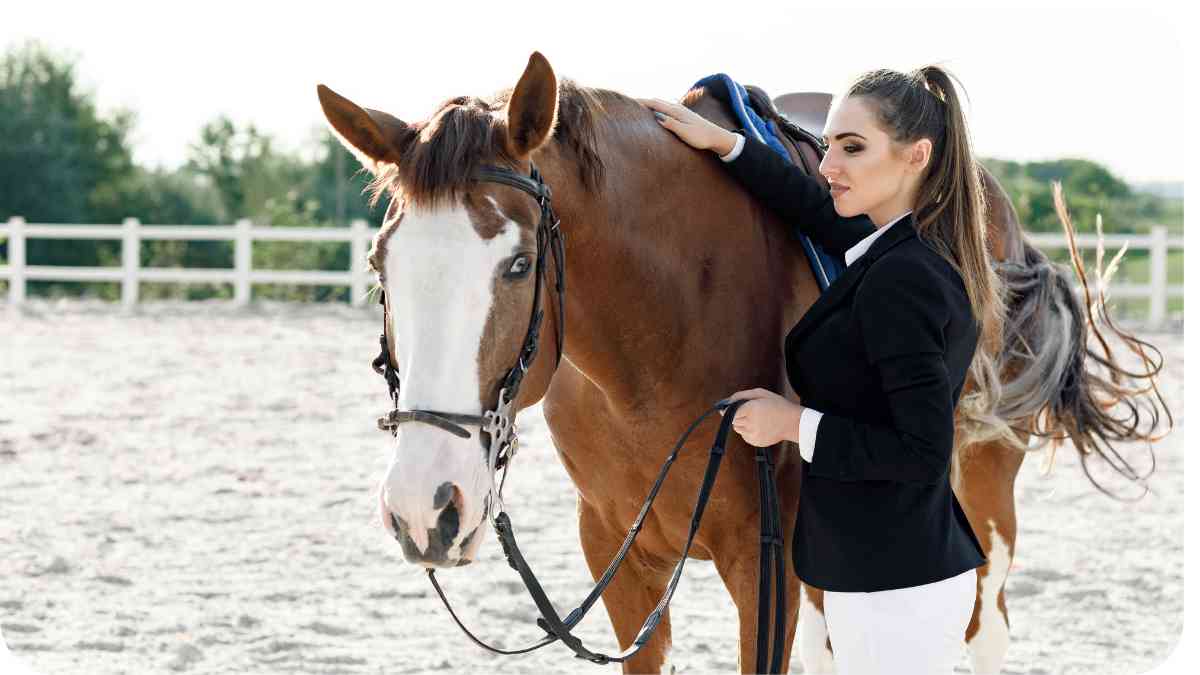Welcome to this comprehensive guide on understanding your horse’s vision. As an experienced equestrian and content writer, I aim to provide you with valuable insights into how horses see the world around them.
By delving into their visual abilities, challenges, and ways to enhance their visual comfort, we can develop a deeper understanding and connection with our equine companions.
| Takeaways |
| Understanding a horse’s vision helps improve communication and training |
| Horses have unique visual abilities and limitations compared to humans |
| Visual acuity and color perception differ from those of humans |
| Peripheral and binocular vision play important roles in a horse’s perception |
| Night vision adaptations allow horses to navigate in low light conditions |
| Common vision problems should be promptly addressed by a veterinarian |
| Learning to interpret a horse’s body language aids in understanding their visual needs |
| Factors like age, genetics, and environment can affect a horse’s vision |
| Enhancing visual comfort includes providing natural light and minimizing distractions |
| Awareness of vision-related considerations is crucial for safe riding and training |
| Taking safety precautions helps prevent accidents and eye injuries |
| Further reading and seeking professional veterinary advice are recommended for more in-depth knowledge |
2. How Horses See: An Overview
Horses have a unique visual system that differs from humans and other animals. Understanding their visual abilities and limitations allows us to adapt our training methods, ensure their safety, and optimize their well-being. In this section, we’ll explore the fascinating world of equine vision and delve into the factors that influence how horses perceive their surroundings.
When hitting the trails, remember that trail riding etiquette is essential for a pleasant experience. Learn more about trail riding etiquette and ensure everyone’s safety and enjoyment.
3. The Anatomy of a Horse’s Eye

To better comprehend a horse’s vision, it’s crucial to grasp the underlying structure of their eyes. Horses possess large and expressive eyes that work in tandem with various anatomical features. In this section, we’ll discuss the intricate details of a horse’s eye, including the cornea, lens, retina, and more.
| Eye Structure | Description |
| Cornea | Transparent outer layer protecting the eye |
| Lens | Adjusts focus and allows light to pass through |
| Retina | Light-sensitive layer at the back of the eye |
| Optic Nerve | Transmits visual information to the brain |
4. Visual Acuity and Color Perception
Horses’ visual acuity and color perception differ significantly from humans. While they possess impressive visual acuity in certain areas, their perception of colors is limited. In this section, we’ll delve into the fascinating intricacies of a horse’s visual acuity, color spectrum, and their capability to distinguish between shades.
Prioritize safety on your trail riding adventure with these valuable safety tips. Being prepared and informed will make your ride both safe and enjoyable.
5. Peripheral Vision and Binocular Vision
Peripheral vision and binocular vision play crucial roles in a horse’s daily life, particularly when it comes to survival instincts and interactions with the environment. By understanding the extent and limitations of their peripheral and binocular vision, we can provide appropriate training methods and ensure their safety.
| Vision Type | Description |
| Peripheral Vision | Wide field of view, ideal for detecting threats |
| Binocular Vision | Overlapping field of view, important for depth perception |
6. Night Vision and Adaptation to Low Light Conditions
Horses possess remarkable night vision adaptations that allow them to navigate and graze in dim lighting. This section explores the various mechanisms behind their excellent low light vision and provides insights into how we can optimize their comfort during nighttime activities.
Looking for the perfect trail riding destinations in the US? Explore the top ten most scenic spots in this guide to scenic trail riding destinations.
7. Common Vision Problems in Horses

Similar to humans, horses can experience various vision problems that may impact their daily activities and overall well-being. Familiarizing ourselves with these common issues enables us to recognize symptoms and seek appropriate veterinary care. In this section, we’ll discuss prevalent equine vision problems and potential treatments.
8. Understanding Your Horse’s Body Language
Gaining knowledge about a horse’s body language is essential for effective communication, training, and addressing their visual needs. By interpreting their subtle cues and expressions, we can better understand their comfort level, emotions, and responses. This section focuses on deciphering your horse’s body language and how it relates to their visual perception.
| Body Language Cue | Interpretation |
| Ears Forward | Focused and attentive |
| Ears Pinned Back | Indication of aggression or discomfort |
| Wide Eyes | Alert or frightened |
| Relaxed Eyes | Calm and content |
9. Factors That Affect a Horse’s Vision
Various factors, such as age, genetics, and environmental conditions, can influence a horse’s vision. By considering these factors, we can better address their visual needs and provide optimal care. This section explores the impact of different factors on a horse’s vision and shares tips for promoting visual health.
Before you head out on the trails, make sure you have the essential horseback riding equipment you need. From saddles to helmets, being well-prepared is key to a successful ride.
10. Tips for Enhancing Your Horse’s Visual Comfort
As horse owners and caretakers, it’s our responsibility to ensure our horses’ visual comfort and well-being. This section offers practical tips and recommendations on creating an environment that supports their visual needs.
| Tips for Enhancing Your Horse’s Visual Comfort |
| Provide ample natural light in stables and paddocks |
| Avoid using bright, harsh artificial lighting |
| Keep the horse’s living area clean to minimize dust |
| Install visually stimulating objects in the paddock |
| Incorporate varied terrain to stimulate visual interest |
Horses thrive in environments that cater to their visual needs. By providing ample natural light and avoiding harsh artificial lighting, you create a more comfortable and visually satisfying space for your horse. Additionally, keeping their living area clean helps prevent eye irritations caused by dust or debris.
To enhance your horse’s visual experiences, consider incorporating visually stimulating objects in the paddock. This could include hanging reflective objects or introducing colorful toys that encourage exploration and curiosity.
The introduction of varied terrain not only provides physical exercise but also stimulates visual interest, allowing your horse to engage with their surroundings.
11. Riding and Training Considerations
Understanding your horse’s visual abilities is crucial when it comes to riding and training. By taking into account their visual limitations and adapting your techniques accordingly, you can ensure effective communication and a more positive training experience.
When riding, keep in mind that your horse’s peripheral vision is wider than yours. Be aware of potential distractions in their field of view and use clear and consistent signals to guide them. Additionally, consider their depth perception; jumping or navigating obstacles may require more precise signaling and training.
During groundwork or ground training sessions, be mindful of your horse’s body language. Watch for any visual signs of discomfort or anxiety, such as wide eyes or tension in their facial muscles. By recognizing these cues, you can adjust your training approach and provide a more relaxed and enjoyable experience for your horse.
Don’t underestimate the importance of properly fitting horseback riding boots for a comfortable and safe trail riding experience. Learn how the right boots can enhance your ride
| Riding and Training Considerations |
| Be mindful of your horse’s peripheral vision |
| Use clear and consistent signals |
| Consider the impact of depth perception |
| Watch for visual signs of discomfort |
12. Safety Precautions for Horse Owners
Ensuring the safety of both you and your horse is paramount. By taking certain precautions, you can minimize potential risks associated with their vision and create a safe environment for everyone involved.
First and foremost, always wear appropriate protective gear, including a helmet, when working with or riding horses. Accidents can happen, and protecting your head and face is crucial.
When approaching a horse, make sure they can see you coming. A startled horse can react unpredictably, leading to potential accidents. Approach from their field of vision, allowing them to recognize your presence and maintain a calm demeanor.
| Safety Precautions for Horse Owners |
| Wear appropriate protective gear |
| Approach horses from their field of vision |
Always be cautious when handling sharp objects or tools near your horse’s face or eyes. Accidental contact can cause serious injuries. Maintain a safe distance and handle equipment with care to minimize any potential risks.
Lastly, keep regular veterinary appointments to monitor your horse’s overall health, including their vision. Regular check-ups allow early detection of any potential eye problems and ensure prompt treatment if needed.
13. Frequently Asked Questions (FAQs)
Q: Can horses see in the dark?
A: While horses have excellent night vision compared to humans, they cannot see in complete darkness. They possess adaptations that help them see better in low light conditions, but some level of ambient light is still necessary for them to perceive their surroundings accurately.
Q: How does a horse’s vision affect their behavior?
A: A horse’s vision plays a significant role in their behavior and responses. Their visual perception influences their reactions to unfamiliar objects, ability to assess distances, and sense of safety. Understanding their visual abilities allows us to provide a more predictable, comfortable, and less stressful environment for our equine partners.
Q: How do I know if my horse has a vision problem?
A: Look for signs such as excessive blinking, cloudiness or discharge from the eyes, frequent stumbling, reluctance to engage in activities requiring clear vision, or notable changes in behavior. If you observe any of these signs, it’s crucial to consult your veterinarian for a thorough examination.
Q: Can horses distinguish colors?
A: Horses have dichromatic vision, which means they can perceive colors but have a limited color spectrum compared to humans. They are most sensitive to shades in the blue and green spectrum but struggle to distinguish between certain colors like red and orange.
14. Conclusion
Understanding your horse’s vision is key to developing a deep bond, ensuring their safety, and optimizing their overall well-being. By appreciating their unique visual abilities, anatomy, and potential vision problems, you can provide tailored care, training, and an enriching environment.
Remember to consider factors that affect their visual comfort and take appropriate measures to enhance their experience. By implementing simple adjustments and incorporating expert insights, you can create an environment that fosters both physical and visual health for your
Further Reading
Here are some additional resources to further expand your knowledge on understanding your horse’s vision:
- Equine Helper: How Horses See: This article provides a detailed overview of equine vision, including visual acuity, color perception, and common vision problems. It delves into the anatomical aspects of a horse’s eye and offers insights into how their vision impacts behavior.
- Horse and Rider: Horse Vision and Eyesight: This informative article explores how horses see, including their field of view, night vision, and depth perception. It also includes practical tips on how to optimize your horse’s visual experience during riding and training sessions.
- Horse Health Products: More Than Meets the Eye – Understanding Equine Vision: This comprehensive resource offers valuable information on various aspects of equine vision, including visual acuity, color perception, and eye health. It discusses common vision problems and provides insights into optimizing your horse’s visual comfort.
FAQs
Q: How can I assess my horse’s vision?
A: While you can’t perform an eye check-up yourself, paying attention to any changes in behavior, signs of eye discomfort, or unusual reactions to objects can indicate potential vision problems. Consult a veterinarian for a thorough examination if you have concerns.
Q: Can a horse’s vision affect their performance in competitive events?
A: Yes, a horse’s vision plays a crucial role in their performance. Visual impairments or discomfort can influence their ability to navigate obstacles, judge distances, and respond to cues accurately. It’s important to address any vision issues and ensure they are not hindering their performance.
Q: What can I do to minimize eye injuries in horses?
A: To reduce the risk of eye injuries, ensure that your horse’s living environment is clean and free from sharp objects. Implement safety precautions while handling equipment or performing activities near their face. Regular veterinary check-ups are also important to detect and address any potential eye problems.
Q: Are there any preventive measures to maintain good equine vision?
A: Maintaining a balanced diet, providing regular exercise, and managing environmental factors such as dust levels and lighting can contribute to good visual health in horses. Regular veterinary care, including eye examinations, can help monitor and address any potential issues early on.
Q: Can horses see better during the day or night?
A: Horses have adaptations that allow them to see better in low light conditions, making their night vision more efficient compared to humans. However, they still have the advantage of clearer vision during daylight hours when their eyes can perceive colors and details more effectively.
Please note that while these resources and FAQs provide useful information, consulting with a qualified equine veterinarian is always recommended for accurate and personalized advice regarding your horse’s vision and health.

Hi there! My name is Hellen James, and I’m a horse riding expert. I’ve been riding horses since I was just a kid—and it’s been my passion ever since. But getting started with horse riding can be overwhelming. There’s so much to learn! If you’re looking for a way to get started and make sure you’re doing it right, I’m here to help.


